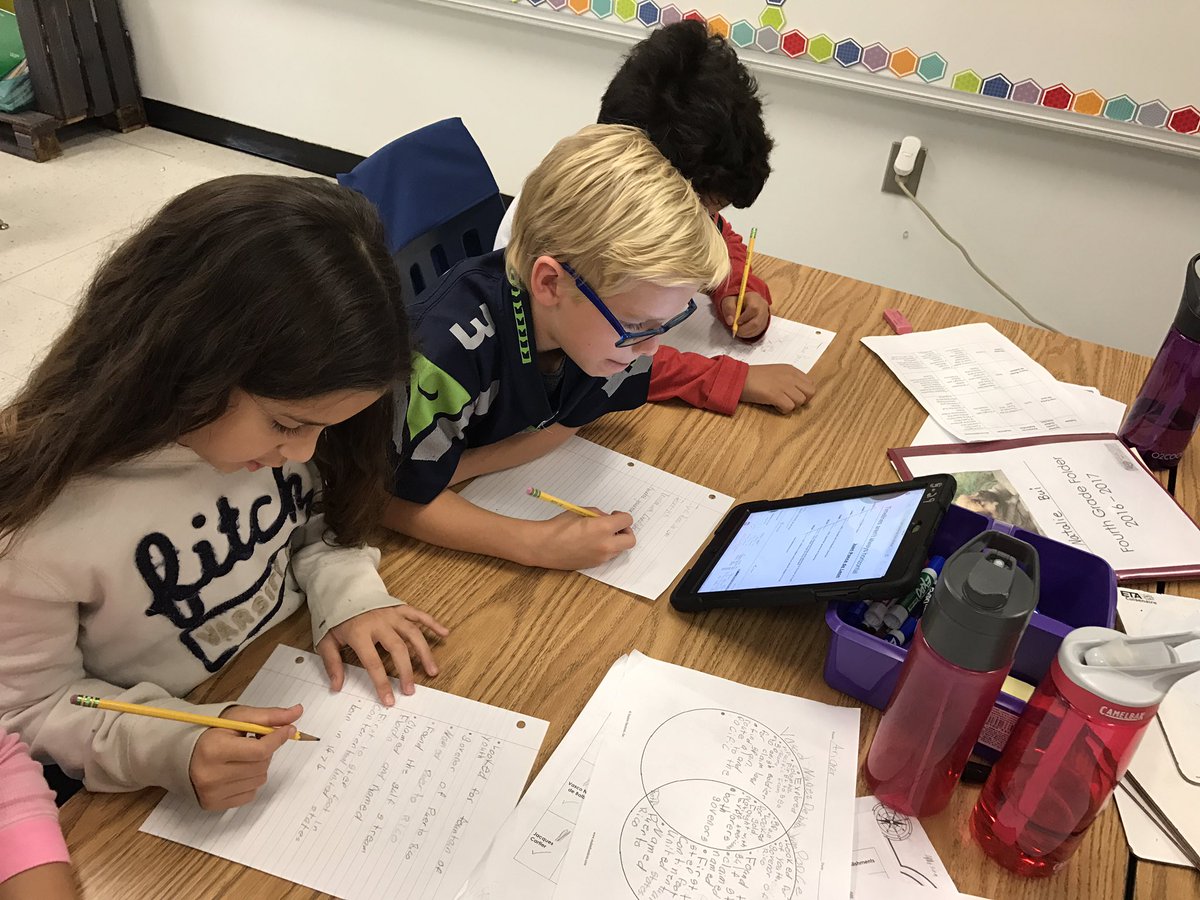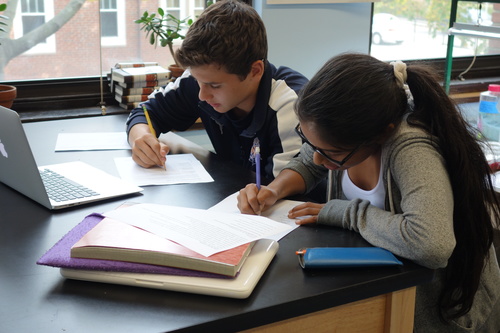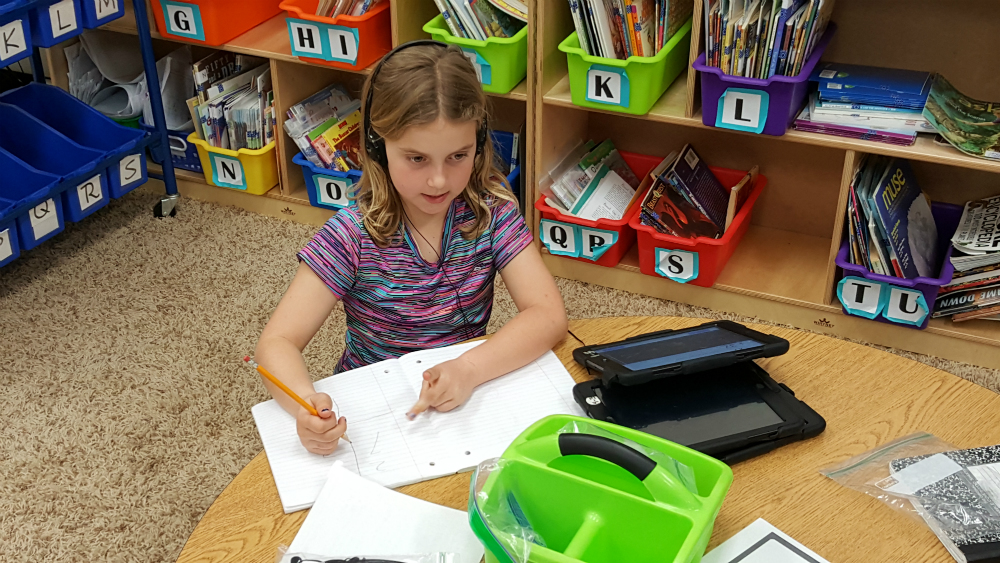Old School Meets New School
Using Technology to Personalize Reading and Writing at the Elementary Level
KENNESAW, Ga. (Jan 31, 2018) — These days, when pressed for time to deliver content with the pacing guide, the digital tools and techniques we use with our students are sometimes limited to online activities, video resources and unit projects. But we forget that it is often just as easy to incorporate new technology into those three old school learning areas: reading, writing & arithmetic! Our students sometimes struggle with seeing the relevance of what we do in the classroom with what they experience in the real world, having to often shut themselves down when they enter class and getting hooked up the moment they get home. But what if there were a way we could use tools like Seesaw, Skitch, Google Classroom and Office 365 to motivate kids to complete their work while using it to demonstrate what they have learned at the same time? As teachers, we often have difficulty finding time to fit in just one more thing, but are also guilty of forgetting to let go and let kids be accountable for their own learning and to let students use the technology to assist, to guide and to demonstrate where they are and what they still need to know at their own pace. Sometimes, the simple use of adding a digital element can not only save us time but also help to personalize the learning for our students and make great use of transitional moments between activities. Below are just a few ways that I have seen technology used in the reading and writing classroom to motivate kids, document progress and to engage our digital students in a more relevant extension of old school standards that will help them to assess their own learning moving forward in a positive, new school way.
Skills Assessment: As a teacher, the variety of skills and standards we are attempting to teach and
assess is vast and it is often difficult to find time to catch a student accurately
demonstrating what they have learned. As the desire and ability of our students to
get digitally connected increases, allow students an opportunity to self assess and
post their own achievements for you to review at a later time in Seesaw, Google Classroom
or in a shared  folder through Office 365. Working on a specific grammar skill or writing convention?
Have students snap a pic of their work and document how they feel about their own
progress using text captions or by attaching an audio description. Make sure they
explain which skill they believe they have achieved and why. Using a program like
Skitch or Seesaw with a markup feature to clarify revisions and proper use of grammar
can help students further identify their evidence; have them underline the skills
and annotate/describe how they are using them as a writer. Even having students model
and document the use of note taking strategies and parts of speech can be done by
uploading a quick pic of their work. Tired of carrying home all those writing and
grammar notebooks? Let students upload photos of each weeks work and you can check
their progress online at anytime with documentation galore!
folder through Office 365. Working on a specific grammar skill or writing convention?
Have students snap a pic of their work and document how they feel about their own
progress using text captions or by attaching an audio description. Make sure they
explain which skill they believe they have achieved and why. Using a program like
Skitch or Seesaw with a markup feature to clarify revisions and proper use of grammar
can help students further identify their evidence; have them underline the skills
and annotate/describe how they are using them as a writer. Even having students model
and document the use of note taking strategies and parts of speech can be done by
uploading a quick pic of their work. Tired of carrying home all those writing and
grammar notebooks? Let students upload photos of each weeks work and you can check
their progress online at anytime with documentation galore!
Working on reading fluency or articulation in foreign languages? Ask students to take video of themselves demonstrating their own ability in those areas; this also works great for any standard which asks students to explain, identify or demonstrate what they have learned. As each student accomplishes a new skill in their own time, their digital portfolio is only a post away!
Goal Setting: After an assessment, the video tool is also very useful for student feedback. Help your students to be critical thinkers by evaluating how they did. What did they think they did well? What are they most proud of? What do they need to continue to work on? What can they do differently next time to help? Have students record themselves reflecting on their outcome and creating new goals based on how they did so their future work becomes even more meaningful with each lesson you teach!
 Although you might initially help students set goals by coplanning them together in
a small group setting, as students reflect on the work they have already completed,
help them to self assess and determine their next steps. Provide students with a copy
of the learning progression, unit standards or the skills needed to achieve the next
ability level. It is easier for students to achieve the required skills and goals
if they are clearly defined and laid out before them.
Although you might initially help students set goals by coplanning them together in
a small group setting, as students reflect on the work they have already completed,
help them to self assess and determine their next steps. Provide students with a copy
of the learning progression, unit standards or the skills needed to achieve the next
ability level. It is easier for students to achieve the required skills and goals
if they are clearly defined and laid out before them.
As students feel like they have accomplished each goal, have them snap a pic of their work with an annotation, video reflection or work sample and save it to their learning portfolio, Google Classroom or class folder in their Office 365 account. By allowing students to understand, evaluate and post evidence of their own work, you are helping to hold them accountable for their own learning, make it more meaningful and helping them to see the progress they are making each day toward the personalized goals you set before them.
Peer & Self Editing: Students are often in a hurry to get done with writing assignments, eager to turn it in quickly and check it off their list. In order to help them understand the expectations of each assignment and their anticipated performance before the assignment grade hits home much lower than they expected, try using a few of these techniques for self-assessment and editing before the grade becomes final.
First, provide students with a detailed rubric including specific items to check for: structure of writing, checking for spelling and grammar errors, use of vocabulary,
etc. Have each student grade their own work using the assigned rubric and then answer
two simple questions: Is this the grade you expected to receive on this assignment?
and using the provided rubric, what can you do to improve your score on this assignment?
Use flexible pacing by allowing students to make revisions at least once before turning
in their work provided they turned in the original draft before the due date. Secondly,
ask students to have one other student assess their work using the same rubric after
the initial revisions have been made; this will not only help improve the quality
of their work, but also help them to see valuable skills they need to work on in the
future. Microsoft Forms can be used to easily create a quick grading rubric which can be used over and over
again by students with each unit. Many students also enjoy using Office 365 online
to write and edit their work; Office online can also be used to allow for student
collaboration on assignments and allow for peer editing in a digital environment.
for: structure of writing, checking for spelling and grammar errors, use of vocabulary,
etc. Have each student grade their own work using the assigned rubric and then answer
two simple questions: Is this the grade you expected to receive on this assignment?
and using the provided rubric, what can you do to improve your score on this assignment?
Use flexible pacing by allowing students to make revisions at least once before turning
in their work provided they turned in the original draft before the due date. Secondly,
ask students to have one other student assess their work using the same rubric after
the initial revisions have been made; this will not only help improve the quality
of their work, but also help them to see valuable skills they need to work on in the
future. Microsoft Forms can be used to easily create a quick grading rubric which can be used over and over
again by students with each unit. Many students also enjoy using Office 365 online
to write and edit their work; Office online can also be used to allow for student
collaboration on assignments and allow for peer editing in a digital environment.
Online Publishing: Students are writing for a variety of reasons but most often, not for themselves.
Writers often need to be inspired by a topic or a purpose that is meaningful to them
in order for the content to truly flow and reflect their true ability. By allowing
students to publish their work online through sites like Weebly and Storybird, we can help make their writing more authentic by giving students a much broader
voice and the opportunity for their opinions and perspectives to be heard by more
than just their teacher. To help personalize the writing process, allow for some flexibility
in student choice in their writing assignment while creating a challenge for students
to persuade their own readers with their self created content. You can do this through
Google Classroom or a classroom blog where students can view, like and comment on
each others work. This interactivity between students can help to inspire young writers,
give their writing a purpose and help to give them a sense of worth if they know that
their own words can help to persuade one of their peers to face a challenge, perform
a task or even to try something new they had never heard of before!
As an extension or positive reward for student behavior, offer “Feedback Fridays” where students have an opportunity to review each other’s work and provide positive yet constructive criticism to each others posts; set guidelines ahead of time (THINK framework) and challenge students to respond to others who they don’t really know or have not received other comments to help foster a sense of community in your classroom.
Audio Help: Sometimes, hearing our content is the best medicine. Using Seesaw or Vocaroo to have students record themselves can allow them to hear the errors and improvements
they need to make in their reading or writing assignments straight from their own
mouths! Young readers and ESOL learners can use this strategy to help themselves improve
their own fluency; have them record themselves reading a book at their current reading
level and give it a listen. Even young learners can pick up on simple mistakes in
pronunciation and pacing with grammar; have them delete it and re-record helping
students demonstrate growth and perseverance, and if needed, do it one more time!
 Finished with that writing assignment with time to spare? Have students record themselves
reading it aloud; upon playback, the student might hear some areas where gaps in
content, grammar or word choice can easily be improved. Even the student who thinks
they have nothing to say or to write about can often be inspired by the simple opportunity
to talk. When the words don’t come, let students use a voice recorder to explain
everything they know about a topic and then allow them to take down notes upon playback;
they will often be very surprised how much they knew when they finally get it down
on paper.
Finished with that writing assignment with time to spare? Have students record themselves
reading it aloud; upon playback, the student might hear some areas where gaps in
content, grammar or word choice can easily be improved. Even the student who thinks
they have nothing to say or to write about can often be inspired by the simple opportunity
to talk. When the words don’t come, let students use a voice recorder to explain
everything they know about a topic and then allow them to take down notes upon playback;
they will often be very surprised how much they knew when they finally get it down
on paper.
There are so many tools out there to help you as teachers and our students turn old
school standards into new school techniques, many which can help save you time as
a teacher and turn the learning over to your students while allowing you more flexibility
to work with kids individually in class. The next time you are getting ready to collect
another piece of paper or are shuffling to fit it all in, ask yourself ‘how can this
new technology help to inspire my students to work harder, document their progress
and gain me more classroom time in the process?” My guess is, that with our help
and the tools you have readily before you, that an alternative digital solution is
not too far away.
--
Ann Marie Carrier
Instructional Technology Specialist
iTeach at Kennesaw State University
















